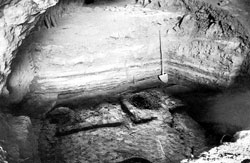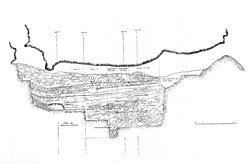
Liguria. The Arene Candide cave (province of Savona)
The Arene Candide cave is situated on the southern slope of Monte Caprazoppa, which slightly projects into the sea from the coastal chain, forming a little promontory between Finale Marina and Borgio. The cave, the largest of the many that perforate the mountains of the Ligurian littoral, forms a kind of natural loggia looking southwards through three large apertures on the long side, from which extensive views open up on the sea. Light-filled, warm, airy, sufficiently dry, at least in the cold season, and well sheltered from the cold northerly winds, the cave must have offered ideal conditions for settlement in prehistoric times. The cave now forms a large elongated cavity in the rock, on the East-West axis, parallel, that is, to the face of the rocky promontory in which it opens. The palaeoethnological discovery of the cavern, and its first scientific explorations, were made by Arturo Issel, Genoese-born professor of geology and palaeontology, in 1864 and in the following years. In view of the long activity of excavations conducted in the cave, it was to be feared that precious little of the prehistoric deposit would have remained in situ. Nonetheless Luigi Bernaḅ Brea ever since his first exploration of the cave in 1940 could ascertain that undisturbed parts of the deposit still remained in various points; he then began a series of excavation campaigns, conducted in collaboration with Luigi Cardini of the Istituto di Paleontologia Umana.
The stratigraphy of the deposits with pottery reached a depth of 2.70 m. The successive strata, from bottom to top, led from the remains of the early Neolithic, middle Neolithic, late Neolithic, the Bronze Age (only a few traces) and the Iron Age. In other words, the stratigraphy yielded one of the most important archaeological sequences for the prehistory of the Western Mediterranean. The exploration and analysis of the Mesolithic strata throughout the whole area of the excavation were completed by L. Cardini during other excavation campaigns from 1941 onwards. Below the Mesolithic strata the existence of a Pleistocene deposit was ascertained; the excavations uncovered five hearths belonging to the Upper Palaeolithic and the burial of a young man with rich grave goods. The excavation then had to stop, having encountered large masses of rock impossible to remove at a depth of 8.50 m. Four new excavations (V-VIII) could be completed between 1948 and 1950. With the exception of VII, mainly devoted to the exploration of the Mesolithic strata, these campaigns especially focused on the deposit containing pottery fragments which was excavated through almost the whole area of the eastern chamber.
Bibliography:
- L. Bernabò Brea, Gli scavi nella caverna delle Arene Candide, Parte I. Gli strati con ceramiche, Bordighera 1946, pp. 1-364.
- L. Bernabò Brea, Gli scavi nella caverna delle Arene Candide, Parte prima. Gli strati con ceramica, Vol. 2: Campagne di scavo 1948-50, Bordighera 1956, pp. 1-296.
- A. Bietti, The Upper Pleistocene deposit of the Arene Candide Cave (Savona, Italy) new studies on the 1940-42 excavations, Quaternaria Nova IV, Roma 1994.
- R. Maggi, Arene Candide: A functional and Environmental assessment of the Holocene sequence (Excavations Bernabò Brea - Cardini 1940-1950), in Memorie dell'Istituto Italiano di Paleontologia Umana, Nuova serie, Roma 1997, pp.1-643.
- S. Tinè (a cura di), Il neolitico nella caverna delle Arene Candide (scavi 1972-1977), Bordighera, 1999.

